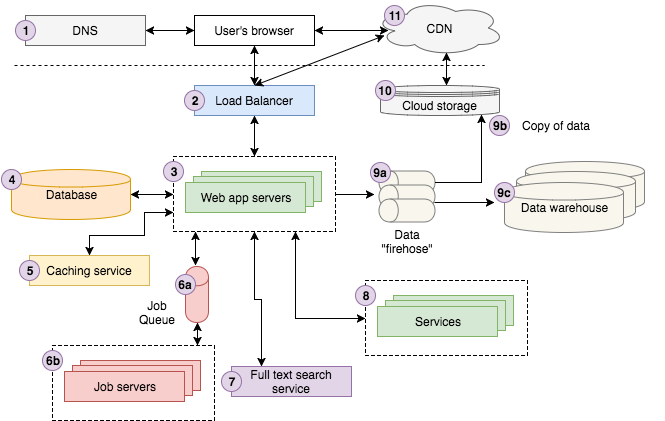Key Points
References
| Reference_description_with_linked_URLs_______________________ | Notes______________________________________________________________ |
|---|---|
| https://tomcat.apache.org/ | |
| https://tomcat.apache.org/tomcat-9.0-doc/index.html | Tomcat doc home |
| https://tomcat.apache.org/tomcat-9.0-doc/appdev/index.html | Tomcat doc for app dev |
| http://localhost:8080/ | Local instance |
D:\dsfw\java8.bat D:\dsfw\java8.bat.txt | Tomcat startup bat file |
Key Concepts
Common Web App Server Architecture - Request Processing
https://engineering.videoblocks.com/web-architecture-101-a3224e126947
Information flow
A user searches on Google for “Strong Beautiful Fog And Sunbeams In The Forest”. The first result happens to be from Storyblocks, our leading stock photo and vectors site. The user clicks the result which redirects their browser to the image details page. Underneath the hood the user’s browser sends a request to a DNS server to lookup how to contact Storyblocks, and then sends the request.
The request hits our load balancer, which randomly chooses one of the 10 or so web servers we have running the site at the time to process the request. The web server looks up some information about the image from our caching service and fetches the remaining data about it from the database. We notice that the color profile for the image has not been computed yet, so we send a “color profile” job to our job queue, which our job servers will process asynchronously, updating the database appropriately with the results.
Next, we attempt to find similar photos by sending a request to our full text search service using the title of the photo as input. The user happens to be a logged into Storyblocks as a member so we look up his account information from our account service. Finally, we fire off a page view event to our data firehose to be recorded on our cloud storage system and eventually loaded into our data warehouse, which analysts use to help answer questions about the business.
The server now renders the view as HTML and sends it back to the user’s browser, passing first through the load balancer. The page contains Javascript and CSS assets that we load into our cloud storage system, which is connected to our CDN, so the user’s browser contacts the CDN to retrieve the content. Lastly, the browser visibly renders the page for the user to see.
web app server
execute the core business logic that handles a user’s request and sends back HTML to the user’s browser. To do their job, they typically communicate with a variety of backend infrastructure such as databases, caching layers, job queues, search services, other microservices, data/logging queues, and more.
database server
Databases provide ways of defining your data structures, inserting new data, finding existing data, updating or deleting existing data, performing computations across the data, and more.
cache service
A caching service provides a simple key/value data store that makes it possible to save and lookup information in close to O(1) time. Applications typically leverage caching services to save the results of expensive computations so that it’s possible to retrieve the results from the cache instead of recomputing them the next time they’re needed. An application might cache results from a database query, calls to external services
batch jobs
use job queues and servers - Most web applications need to do some work asynchronously behind the scenes that’s not directly associated with responding to a user’s request. For instance, Google needs to crawl and index the entire internet in order to return search results. It does not do this every time you search. Instead, it crawls the web asynchronously, updating the search indexes along the way.
background services
security authorization, payments, accounts, etc
Once an app reaches a certain scale, there will likely be certain “services” that are carved out to run as separate applications. They’re not exposed to the external world but the app and other services interact with them.
CDN servers
CDN stands for “Content Delivery Network” and the technology provides a way of serving assets such as static HTML, CSS, Javascript, and images over the web much faster than serving them from a single origin server. It works by distributing the content across many “edge” servers around the world so that users end up downloading assets from the “edge” servers instead of the origin server.
Tomcat Setup
Tomcat Startup
http://localhost:8080/manager/status
401 Unauthorized
You are not authorized to view this page. If you have not changed any configuration files, please examine the file conf/tomcat-users.xml in your installation. That file must contain the credentials to let you use this webapp.
For example, to add the manager-gui role to a user named tomcat with a password of s3cret, add the following to the config file listed above.
<role rolename="manager-gui"/> <user username="tomcat" password="s3cret" roles="manager-gui"/>
Note that for Tomcat 7 onwards, the roles required to use the manager application were changed from the single manager role to the following four roles. You will need to assign the role(s) required for the functionality you wish to access.
- manager-gui - allows access to the HTML GUI and the status pages
- manager-script - allows access to the text interface and the status pages
- manager-jmx - allows access to the JMX proxy and the status pages
- manager-status - allows access to the status pages only
The HTML interface is protected against CSRF but the text and JMX interfaces are not. To maintain the CSRF protection:
- Users with the manager-gui role should not be granted either the manager-script or manager-jmx roles.
- If the text or jmx interfaces are accessed through a browser (e.g. for testing since these interfaces are intended for tools not humans) then the browser must be closed afterwards to terminate the session.
For more information - please see the Manager App How-To.
Potential Value Opportunities
Potential Challenges
Candidate Solutions
Step-by-step guide for Example
sample code block
